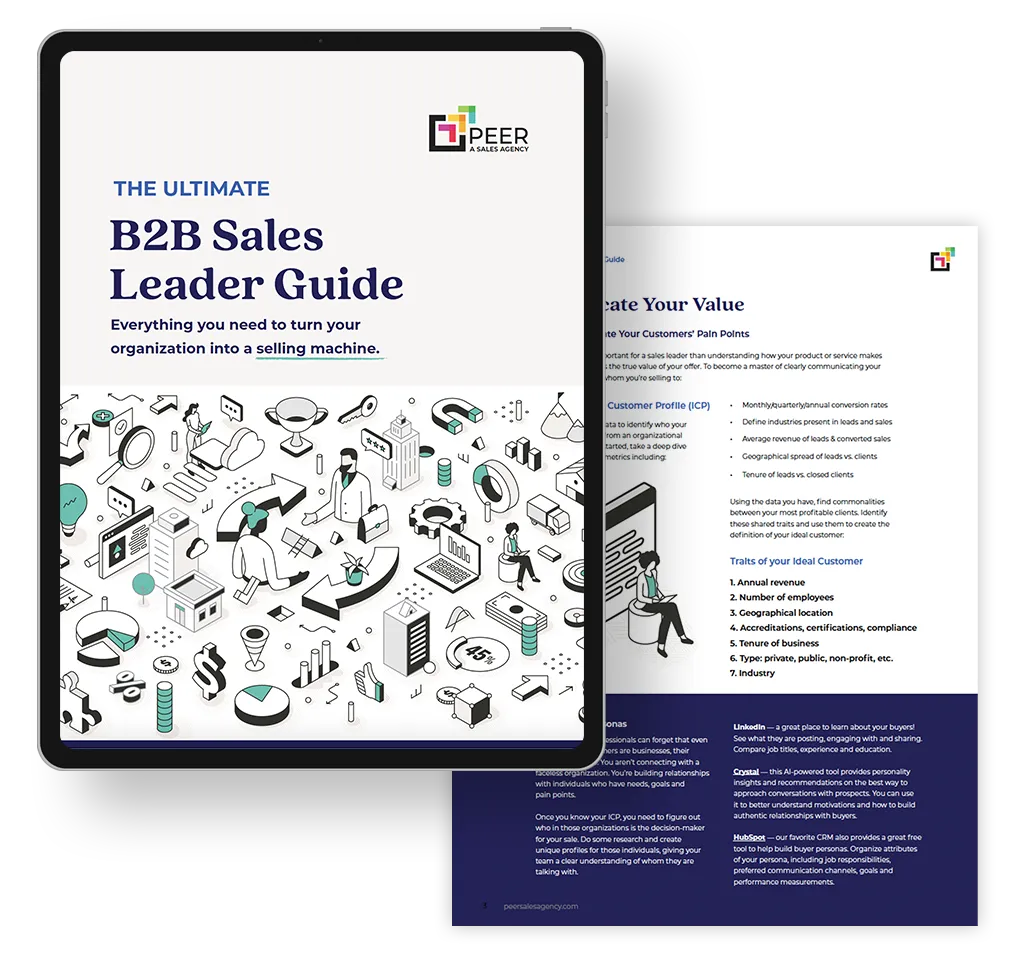How to Create B2B Buyer Personas to Close More Deals
If you’re in the business of selling, you already know that the key to success isn’t just about pushing your product or service onto anyone with a pulse. It’s about finding the perfect fit – that magic moment when your offering meets your customer’s needs like a lock and key.
But here’s the kicker: If you’re clueless about your ideal customer and what drives them, it’s like trying to hit a bullseye blindfolded in a game of darts.
So, if you’re tired of playing games with your sales strategy and want to turbocharge your closing rates, you’re in the right place.
What Is a B2B Buyer Persona?
A buyer persona is like a detailed character sketch of your prospective customers. It’s a fictional representation that combines the key traits, preferences, and behaviors of your ideal buyers. It helps you understand who your customers are, what motivates them, what challenges they face, and how they make purchasing decisions.
Having a well-defined customer persona allows you to tailor your sales approach and messaging to resonate with these specific individuals. It’s like having a personalized playbook that guides you on how to engage and ultimately, close deals more effectively.
What Is an Ideal Customer Profile?
Before you can create your buyer personas, you need to first identify your Ideal Customer Profile. Let me tell you, this is a must-have for all B2B companies.
Your ICP defines the traits that make a company a perfect customer, like industry, size, location, and budget. It’s essentially a “dream customer” blueprint.
Having a well-defined ICP helps you prioritize your sales efforts. Instead of casting a wide net and chasing every lead, you can focus your energy and resources on those prospects who are most likely to buy and provide long-term value. It streamlines your sales process, boosts your efficiency, and increases your chances of closing deals with customers who are the perfect match for what you’re offering.
Read: Step-by-Step Guide to Creating Your Ideal Customer Profile
Why B2B Buyer Personas Are Important to Your Business
The answer is simple: they help you understand whom you are selling to and increase your chances of closing deals. Let me break it down for you:
- Tailoring your outreach: Armed with a buyer persona, you can speak the language of your ideal customer. You can create content that addresses their pain points and offers solutions that resonate with them.
- Building trust and credibility: By showing that you understand and care about their unique challenges, you establish a connection with your target audience. They see you as a reliable partner who can solve their problems.
- Increasing chances of closing deals: When you have a deep understanding of your target audience, you can craft sales strategies and messages that speak directly to their needs. This targeted approach increases the likelihood of converting prospects into customers.
How to Create Buyer Personas that Will Help Close More Deals
Buyer personas are an essential tool for any sales team looking to grow their business. Let’s explore how to create one for your team.
1. Identify Your Target Customers
Start by examining your current customer base and look for common characteristics. The goal here is to break your customers into segments that might vary based on need or personality. Often looking at demographic information, such as age, gender, and occupation can help you determine how that impacts their needs.
Then, dive deeper and explore psychographic segmentation. Think behaviors, interests, and values. What motivates them? What challenges do they face? What are their goals? At this point it might just be a guess. But don’t worry, that leads us to the next step.
2. Interview Your Customers
The best way to gather valuable insights is by conducting interviews with your target customers. We want the data in your personas to be as reflective as possible.
Create a list of questions that will help you uncover their motivations, challenges, preferred methods of learning, and their buying process. Ask open-ended questions to encourage detailed responses.
After the interviews, analyze the data collected to identify patterns, similarities, and key themes. Look for common pain points, desires, and preferences among your target customers.
As you complete your interviews, you’ll use this data to build the personas. Grab our template here.
3. Identify Unique Demographic Information
You can customize your sales and marketing strategies to meet your buyers’ specific needs. This can be done based on their job title, role, company size, industry, region, job history, and education.
For example, let’s say your buyer persona is “CRO Melissa,” a Chief Revenue Officer at a mid-sized software company in the technology industry. Melissa has a diverse professional background, having worked in various sales and marketing roles before reaching her current position. She holds a Bachelor’s degree in Business Administration and has completed several sales training programs.
Painting this picture of Melissa helps sales and marketing teams start to understand their target’s personal preferences when reaching out to similar professionals. You can speak their language and highlight how your product or service can specifically benefit their company and industry.
4. Identify Their Goals and Pain Points
Understanding what motivates prospects and the problems they are trying to solve will allow you to tailor your sales approach effectively. It’s also key for creating content that attracts visitors to your site, and helps nurture them down the funnel. Here are some questions you can ask to uncover their goals and pain points:
- What are your customers’ main objectives? Are they looking to increase revenue, improve efficiency, or expand their customer base?
- What challenges do they face in achieving these goals? Is it a lack of resources, outdated technology, or intense competition?
- How does your product or service help address these challenges? How can it contribute to their success?
- What are the specific pain points your customers experience on a daily basis? Is it time-consuming manual processes, unreliable solutions, or a high cost of operation?
- What are their expectations for a solution like yours? What features, benefits, or value propositions are they seeking?
5. Identify Communication Preferences
Knowing how your buyers prefer to engage will help you tailor your approach and increase the chances of a successful interaction.
Start by considering the various communication channels available. Is your target audience more inclined to connect through email, phone, or social media? Each persona may have different preferences.
When we craft our personas, we even go as far as gathering communication preferences specific to personality types. There’s a great tool called Crystal Knows for gathering this data.
How to Use a Buyer Persona
Personas are helpful in guiding the creation of targeted and relevant sales assets, from blog posts to sales scripts. By addressing the pain points, goals, and motivations of your buyers, you provide valuable and impactful information that resonates with your audience. This positions you as a trusted advisor and increases the perceived value of your offering.
You can also use those insights to personalize your sales funnel. Remember, the key is to understand your buyer persona and use that knowledge to craft a personalized experience that addresses their unique challenges and aspirations.
The ROI of Personas
Creating and using personas in your sales process can directly impact your bottom line. By tailoring your approach to the specific needs and preferences of your ideal customers, you increase your chances of closing more deals.
Enhance the customer experience: By aligning your sales funnel with the buyer persona, you can create a more seamless and personalized customer journey. This not only improves the overall buying process, but also establishes a stronger connection with your customers. A positive customer experience leads to higher customer satisfaction and increased loyalty.
Improve sales efficiency: By focusing your marketing and sales efforts on your ideal customer, you eliminate wasted resources on targeting individuals who are less likely to convert. This allows your sales team to prioritize their time and energy on prospects who have a higher likelihood of closing, resulting in a more efficient use of resources.
Drive relevant content creation: Personas guide the creation of targeted and relevant content needed to convert buyers. By addressing the pain points, goals, and motivations of your buyer persona, you provide valuable and impactful information that resonates with your audience.
Read: How To Use Content To Influence B2B Buyers At Every Stage Of The Buyer’s Journey
Ready to Create a B2B Buyer Persona and Start Closing More Deals?
Download our B2B Buyer Persona Template and start improving conversion rates for your business.




